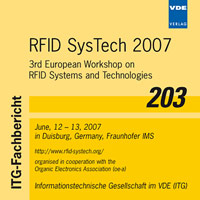Predicting the influence of permittive materials on passive inductive coupled RFID-transponders
Konferenz: RFID SysTech 2007 - 3rd European Workshop on RFID Systems and Technologies
12.06.2007 - 13.06.2007 in Duisburg, Germany
Tagungsband: RFID SysTech 2007
Seiten: 6Sprache: EnglischTyp: PDF
Persönliche VDE-Mitglieder erhalten auf diesen Artikel 10% Rabatt
Autoren:
Cichos, Sven (EUCHNER GmbH + Co KG, D-70771 Leinfelden-Echterdingen, Germany)
Inhalt:
Today inductive coupled RFID-systems are widely used, e.g. for access control, item tagging or wireless safety systems. The design and optimization of antennas for inductive coupled RFID-transponders require the determination of their electrical properties. This includes the calculation of the inductance and resistance of the antenna coil as well as the prediction of the parasitic capacitance. The parasitic capacitance is given not only by the geometry and material parameters of the antenna coil and substrate material. It is also influenced by environmental conditions. A recent method to predict electrical properties of planar antennas and the transponder respectively was developed in "Cichos, Verfahren zur Modellierung von planaren Spulen für den Entwurf und die Optimierung von Antennenspulen induktiv gekoppelter RFID-Transponder". Based on this method the influence of permittive material in the environment of a RFID-transponder, e.g. lamination foils, paper, water etc. can be calculated. It has been illustrated how these effects can be considered in the development process and technology selection of antenna coils. This paper is based on unpublished results of "Cichos, Verfahren zur Modellierung von planaren Spulen für den Entwurf und die Optimierung von Antennenspulen induktiv gekoppelter RFID-Transponder" during the research work at the Forschungsschwerpunkt Technologien der Mikroperipherik of the Technische Universität Berlin.


